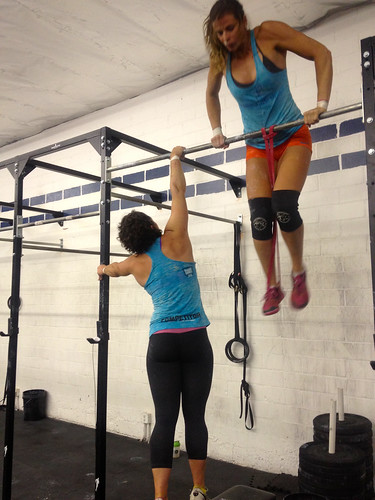Dealing With Injury
Saturday, August 10, 2013:
Mobility/Prehab:
3rds
Handstand Holds x15 seconds
KBS x10 (Lt-Mod weight)
Hollow Rocks x10
Strength:
15 minutes to find 1RM Push Press and practice split Jerk
Notes: Focus on the ‘dip and drive’ for both movements. Sit back in the heels, push the knees out, with no forward inclination of the chest at all. Do not go so heavy on the Jerk that you lose perfect technique.
Conditioning:
For Time:
Run 800m
15 T2B or V-ups
20 KB Swing 32/24kg
Run 400m
20 T2B or V-ups
25 KB Swing 32/24kg
Run 200m
25 T2B or V-ups
30 KB Swing 32/24kg
-20 Min Cap-
Cool Down:
Cobra Stretch 1-2 min
Overhead band distraction 1-2 min
Spend 5-10 min working on a skill/weakness!
Bar Muscle ups…not hands best friend
After Diso’s talk to future competitors of the sport of Crossfit, I really wanted to touch on one subject in particular. Injury. I’ve touched on this before for staying healthy with Crossfit, but if you want to be competitive with the sport of Crossfit, you will encounter injuries. With the amount of volume, increased load, increased Olympic weightlifting, strict resting protocol, injuries will happen. Whether it be an elbow tendinitis, hip bursitis, partial tear of the rotator cuff muscles, eventually if you train hard enough, injuries will happen.
The difference between good athletes and great athletes is how they manage their injuries. Good athletes train through the pain, do not modify their workouts, do not spend the extra time/effort to rehab/stretch/mobilize, and try to ignore the fact that injury is affecting their performance. Great athletes, do the opposite, because if they didn’t, there is no way that they can compete against the best in the world when they are not running at 100% of their bodies total capacity. Look at former women’s Games champ Kristen Clever, she didn’t make the top three female spots in regionals and finished at the bottom of the pack during the games all due to a shoulder and ankle injury. Everyone knows that she gave it her 100%, but when her body was operating at 80%, she literally had no chance.
One of the most common injuries that I have encountered, this week in particular, is tearing of our athlete’s hands after high repetition gymnastics work. I don’t care how “tough” your hands are, skin is skin and will eventually breakdown with enough stress/friction. If you get a substantial tear in your hand, you can easily expect to miss a full week worth of training that involves a gripping a bar of some sort. So no pull-ups, no toes to bar, no muscle ups, no kettle bell swings, probably not snatch or clean and jerk. Thats an entire week of training those movements/muscle groups gone. Yes you can modify and just work on strengthening your legs, but even your legs need adequate time to rest and recover. Over working them can also lead to overuse injuries. And, one week also assumes that you manage your tear properly, because if not, and infection sets in, you can expect that healing will take 2 to 3 times longer than normal tissue healing.
So in this particular situation, I would recommend three different options:
1.Tape your hands (pre-wod)
2. Wear gloves
3. Modify the movement or rep scheme
Please understand that you need to develop a certain amount of toughness in your hands, but that is a gradual process that takes time. Your aren’t going to sudden have hands of steel after one 100+ pull up workout. You need to find the fine line between developing toughness and tearing your hands apart. Just to give you an example of what I may do: I will try to do as much Barbell work or gymnastics work without gloves on to build toughness of my hands without breaking them down to tissue failure, but when I feel them potentially getting to that zone of tearing, I’ll throw some gloves on.
To be proactive, if I see that it work out is going to involve a high-volume of pull-ups, toes the bar, KB swings, I will take the time to tape my hands and possibly wear gloves. This same principle should be used during a competition. The best example of this was the team Chipper at the Games this year. I knew that people’s hands were going to get messed up, so I taped and wore gloves. Well the workout was so taxing on my hands that it actually shredded my gloves and ripped the tape off by the time we go to the snatches. Jesse was not so fortunate. His hands were destroyed. Every time I set up to do my snatches after him, I noticed more and more blood on the bar. Now adrenaline probably got him through that workout, but could you imagine how different his rope climbs would have been after the chipper? Its times like this that you must be smart and realize that you must not only be in great shape, but also be durable.
I don’t want to become over dependent on using gloves, but understanding when is the appropriate time to use them is vital to keeping your training in line in reducing the injury bug along the way.
Which would you prefer? To end your work out early because you tore your hands, or finish an entire work out with gloves on and be ready to go again the next day, the day after, etc.
















